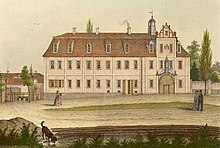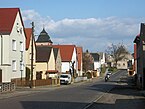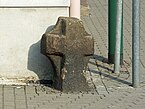Oelzschau (Rötha)
|
Oelzschau
City of Rötha
Coordinates: 51 ° 13 ′ 3 ″ N , 12 ° 31 ′ 26 ″ E
|
|
|---|---|
| Height : | 140 m above sea level NN |
| Residents : | 607 (December 31, 2016) |
| Incorporation : | April 1, 1996 |
| Incorporated into: | Aspen grove |
| Postal code : | 04571 |
| Area code : | 034347 |
Oelzschau is a village belonging to the town of Rötha in the Saxon district of Leipzig . It was incorporated into Espenhain on April 1, 1996, and together with it on August 1, 2015, to Rötha. Since 1948, the neighboring Kömmlitz was incorporated into Oelzschau.
Location and traffic
Oelzschau is located about 17 kilometers southeast of Leipzig in the wide, east-west extending floodplain valley of the Gösel stream . The neighboring towns of Oelzschau are Belgershain , Rohrbach , Hainichen, Trages, Mölbis , Pötzschau and Störmthal, starting from the north and clockwise .
The district road K 7926 leads through Oelzschau. In connection with the K 7925 you can reach the Leipzig-Südost junction of the federal motorway 38 via Stömthal and the federal road 95 via Pötzschau in Espenhain . With the bus lines 141 and 276 of the Central German Transport Association there are direct connections to Espenhain, Borna , Leipzig- Probstheida and Kitzscher .
history
Oelzschau is first mentioned in 1265 in connection with Albertus de Olschicowe as a manor. Nothing is known about the beginnings of the village. The name indicates Sorbian origins, the complex as a street village on the influence of German settlers.
The manor was owned by the von Zehmen family as early as the 14th century and remained so until the 18th century with short interruptions. In the 15th century Conrad von Zehmen received the electoral fiefs on Vorwerk, Dorf and Kirchlehen in Oelzschau and Kemlitz. During the Thirty Years' War, Oelzschau suffered severe damage from Swedish troops in 1642. But Wallenstein is also said to have been to Oelzschau. At the time Tobias von Zehmen owned the manor Oelzschau. Since 1636 he had been tax collector of the Leipziger Kreis and held the position until old age. After his wife died, he gave the goods to the sons in 1656. They suffered a lot in the war. He himself had been ambushed at home and taken away prisoner, and was pillaged while on the run. Children had died for him on the run and abroad. The completely destroyed castle was then completely rebuilt by those of Zehmen.
Christoph Heinrich Adolph von Zehmen inherited the manor Oelzschau when he was born as an orphan in 1728. He lived partly on Oelzschau, married there and later became adjudant general to Charles de Rohan, prince de Soubise and Kurfl in French military service . Chamberlain and castle captain of Neustrelitz. He also wrote the progressive book "System der Landwirtschaft", which, among other things, deals with deep furrows. The last Zehmsche owner of Oelzschau was Carl Amabilis Desiderius von Zehmen. Since he entered service in Hesse and took part in the American war, he sold Oelzschau to Friedr in 1777. Charl. born Junghans, used Hummel in Leipzig, later wife of Boltenstern . After her death in 1837, her son-in-law Heinrich Christian von Rex took over the estate. After that the owners were called Krötzsch, Brand and von Posern. The estate received new farm buildings under von Boltenstern. After numerous additions and conversions by the following owners and lack of care during the GDR era, the building now houses a kindergarten and some apartments.
On July 24, 1719, almost the entire village fell victim to a major fire. 45 residential buildings fell victim to the flames. In addition to the manor and the rectory, only two smaller estates remained. After the fire, the village was rebuilt, all streets and alleys were laid out straight, the houses were built with the gable side facing the street at almost the same distance.
The Oelzschauer Church is probably of Romanesque origin and is one of the oldest in the Leipzig area. In the 17th and 18th centuries, the von Zehmen family carried out numerous alterations, additions and decorations. In 1807 Johann Gottlob Trampeli installed a new organ with 14 registers.
Due to the Saxon rural community order of 1838 , Oelzschau also became a self-governing community with an elected community council and independent of the manor owner. Until 1856 it was part of the Electoral Saxon or Royal Saxon District Office in Leipzig , while the Kömmlitz to the south already belonged to the Borna office . Finally, on February 27, 1856, the jurisdiction of Oelzschau and Kömmlitz was transferred to the Royal Court of Rötha . Since 1875 Oelzschau and Kömmlitz have been part of the Borna administration .
In 1840, at the eastern end of the village, the Württemberg Rittmeister Gustav von Rath built a "Baierische Bierbrauerei", which existed until the end of the 19th century. At the beginning of the 20th century "the chemical factory and the serum institute Bram" was located on the site. This facility with numerous stables for test and donor animals was later attached to the Saxon Serumwerk Dresden and was a major employer in the village. After the fall of the Wall, operations were stopped. The area is now partly used by the Oelzschau animal shelter.
The neighboring Kommlitz, which was incorporated into Oelzschau in 1948, was closely linked to Oelzschau's fate, both through the same landlords, parish and school, and through the same war hardships. Oelzschau and Kömmlitz were incorporated into Espenhain on April 1, 1996, with which they became districts of Rötha on August 1, 2015 . However, since March 1, 2011, Kömmlitz is no longer an independent part of the municipality.
| 1551 | 1764 | 1834 | 1871 | 1890 | 1910 | 1925 | 1939 | 1946 | 1950 | 1964 | 1990 | 1996 | 2000 | 2005 | 2010 | |
| Oelzschau | 25 yards | 30 yards | 405 | 530 | 588 | 543 | 568 | 628 | 954 | 1085 | 845 | 487 | 498 | 657 | 641 | 623 |
| Kommlitz | 14 yards | 15 yards | 123 | 148 | 157 | 140 | 153 | 143 | 221 |
The population of Oelzschau has been stable since the 17th century and increased sharply after the Second World War due to the influx of refugees and displaced persons. Because of the environmental problems caused by the nearby Espenhain plant, the number then fell by more than half. After the environmental problems were eliminated after 1990, the value stabilized at around the pre-war level, albeit with a different structure. While the majority of the local population used to be employed in agriculture, many now only use the place as a residential area.
Attractions
- The Oelzschauer Church has an early Baroque altar from around 1650 and a flat ceiling (around 1700) painted in the style of Venetian Baroque painting above the chancel with the representation of the Passion of Christ in twelve pictures.
- At a street intersection in the village, two stone crosses from the Middle Ages, about 70 centimeters high, face each other. According to legend, they are interpreted as atonement crosses for murders that have been committed.
literature
- Thomas Nabert, Andreas Berkner, Sigrun Kabisch [Red.]: In the Pleiße and Göselland between Markkleeberg, Rötha and Kitzscher , Pro Leipzig, Leipzig 1999, ISBN 3-9806474-1-2
- Hanns-Moritz von Zehmen: Genealogical news about the Meißnian nobility of Zehmen, 1206 to 1906 . Wilhelm Baensch, Dresden 1906
- Oelzschau . In: August Schumann : Complete State, Post and Newspaper Lexicon of Saxony. 7th volume. Schumann, Zwickau 1820, pp. 773-775.
- Richard Steche : Oelzschau. In: Descriptive representation of the older architectural and art monuments of the Kingdom of Saxony. 15. Issue: Amtshauptmannschaft Borna . CC Meinhold, Dresden 1891, p. 85.
- Matthias Donath : Palaces in Leipzig and the surrounding area. edition Sächsische Zeitung Redaktions- und Verlagsgesellschaft Elbland mbH, Meißen 2013, p. 10, Oelzschau p. 111
- GA Poenicke (Ed.): Album of the manors and castles in the Kingdom of Saxony based on nature, newly recorded by F. Heise, Architect. I. Section: Leipziger Kreis. Leipzig 1860, Rittergut Oelzschau, pp. 191–192 (digitized)
Individual evidence
- ↑ http://www.sachsen-gesetze.de/shop/saechsabl/2015/29/read_pdf
- ↑ a b c Oelzschau in the Digital Historical Directory of Saxony
- ↑ a b Die Ephorie Oelzschau in Neue Sächsische Kirchengalerie , Leipzig 1900–1910, Volume Die Ephorie Borna , pp. 790–798
- ^ Karlheinz Blaschke , Uwe Ulrich Jäschke : Kursächsischer Ämteratlas. Leipzig 2009, ISBN 978-3-937386-14-0 ; P. 60 f.
- ^ Karlheinz Blaschke , Uwe Ulrich Jäschke : Kursächsischer Ämteratlas. Leipzig 2009, ISBN 978-3-937386-14-0 ; P. 62 f.
- ↑ Rittergut Oelzschau (Patrimonial Court) ( Memento of the original from December 25, 2011 in the Internet Archive ) Info: The archive link has been inserted automatically and has not yet been checked. Please check the original and archive link according to the instructions and then remove this notice. in the Leipzig State Archives
- ^ The Borna District Administration in the municipal directory 1900
- ↑ http://www.sachsen-gesetze.de/shop/saechsabl/2015/29/read_pdf
- ↑ Kömmlitz in the Historical Directory of Saxony
- ↑ Kömmlitz in the digital historical place directory of Saxony
- ↑ a b c d Notice from the Espenhain Residential Registration Office dated March 21, 2011
- ↑ Edith Ulfers, Harald Kirschner: From Romanesque to Romanticism , in Im Pleiße- and Göselland between Markkleeberg, Rötha and Kitzscher , Pro Leipzig, Leipzig 1999, ISBN 3-9806474-1-2 , p. 139
- ↑ Sühnekreuz.de
Web links
- Oelzschau in the Digital Historical Directory of Saxony









